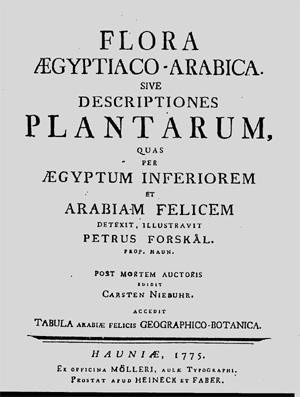
Cover page of the Forsskal's book (1775)
During and after the transformation from a loose tribal confederation to a more organized monarchial state in 1936, the development of science in Saudi Arabia, particularly in matters associated with wild plants had progressed in a steady manner.
The collections of DeMarco (DeMarco & Dinelli, 1974), as part of the work of Italconsult Company for the survey of Agriculture Development, and Mandaville (Saudi Aramco during 1960's) were also remarkable. These collections were deposited in the British Herbaria. In the second half of the previous century plant collection activities were intensified by the active support of University staff such as A.M. Migahid, A.El-Sheikh, U. Bairele, P. Kong, H.M. Hassan, H.A. Abulfatih, etc. Most of these collections are deposited in the Herbarium (KSU) of Botany & Microbiology, King Saud University, Riyadh. As a result of these collections, the first edition of the Flora of Saudi Arabia by Migahid and Hammouda appeared in 1974 and the subsequent second and third editions by Migahid in 1978 and 1988-1990 respectively. Despite all these collections, the intensity of the explorations by various scientists in this region remains unabated.
A large number of publications have also been appeared in the past two decades, featuring the ecology and flora of the south-western region. Due to these intense collections and subsequent studies on plants, the number of species belonging to Saudi Arabia has increased many folds, some of which were new to science.
